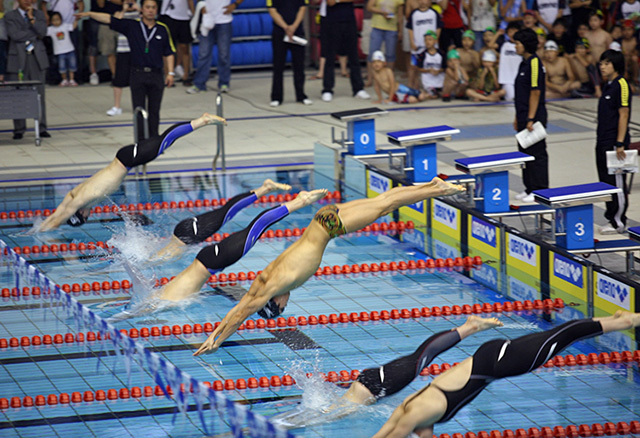Technological doping refers to the use of advanced technology to gain an unfair advantage in sports competitions. This can include equipment enhancements, performance monitoring devices, or biomechanical aids that go beyond standard regulations. Such practices are often controversial and can lead to debates about fairness, ethics, and the true spirit of athletic competition.
 swimsuits can give an unfair advantage
swimsuits can give an unfair advantageTechnological doping represents a complex interplay between the advancement of sports and the pursuit of fairness and integrity. While these innovations can drive the evolution of athletic performance and push the boundaries of what is possible, they also raise significant ethical and legal concerns.
The use of such technology, even when within the rules of the sport, often blurs the line between natural talent and engineered advantage. This creates a contentious environment where the spirit of fair play is challenged, prompting sports governing bodies to continually update regulations to keep pace with technological developments.
As technology continues to evolve, the sports community must navigate these challenges to ensure that progress does not come at the cost of fairness and the fundamental values of competition.
Technological Doping Examples
Swimsuits
Technological advancements in swimsuits, such as full-body polyurethane suits, have dramatically reduced drag and improved buoyancy, leading to numerous world records in swimming, particularly around the time of the Beijing Olympics in 2008. However, these suits were eventually banned by FINA due to their significant impact on performance, raising concerns about fairness and the integrity of the sport.
Motors in Bicycles
Hidden motors in bicycles, often referred to as "mechanical doping," have been used to give cyclists an unfair advantage by providing extra power without detection. This form of cheating has led to increased scrutiny and technological checks by cycling governing bodies to maintain a level playing field.
Illegal Shoes
Specialized running shoes with carbon fiber plates and thick cushioning have been found to enhance performance by improving energy return and reducing fatigue. These "super shoes" have sparked debates and regulations within the athletics community, as they can create a substantial advantage over standard footwear.
Corked Bats
Corked bats, modified by filling them with lighter materials, allow baseball players to swing faster and hit the ball further. Although the practice is illegal and considered cheating, incidents of corked bats have led to suspensions and a closer inspection of equipment by league officials.
Performance-Enhancing Fabrics
Performance-enhancing fabrics, such as compression garments, are designed to improve blood circulation, reduce muscle fatigue, and enhance recovery during and after athletic performance. These garments have raised questions about their impact on fair competition, leading to ongoing debates about their regulation in various sports.
Advanced Aerodynamic Equipment
Advanced aerodynamic equipment, such as specialized helmets and suits, is used to reduce air resistance and improve speed in sports like cycling and skiing. While these innovations can significantly enhance performance, they also create disparities between athletes who have access to cutting-edge technology and those who do not.
Biomechanical Devices
Biomechanical devices, including wearable sensors and exoskeletons, help athletes optimize their movements and improve efficiency. These devices provide a competitive edge by offering real-time feedback and data analysis, which can lead to significant performance improvements but also raises fairness concerns.
Gene Doping
Gene doping involves the use of genetic engineering techniques to enhance athletic performance, such as increasing muscle mass or endurance. This form of doping is particularly controversial due to the ethical implications and potential long-term health risks, prompting strict regulations and monitoring by sports organizations.
High-Tech Prosthetics
High-tech prosthetics, often referred to as "blade runners," are designed to mimic the function of natural limbs and can sometimes offer advantages in terms of energy efficiency and speed. While they enable athletes with disabilities to compete at high levels, debates continue about whether they provide an unfair advantage over able-bodied competitors.
Loopholes in the Rules
Athletes and coaches often exploit loopholes in sporting regulations to gain an edge, such as using unregulated substances or equipment that provide a performance boost without technically breaking the rules. These tactics can lead to rule changes and stricter enforcement as sports organizations strive to uphold fairness and integrity.
Related Pages
- All About Technology in Sports
- The Future of Fitness Testing — technological advances affecting fitness assessment.
- Illegal Sports — activities are classified as illegal due to safety concerns, ethical issues, or their connection to criminal activities.
- Technology and the Olympic Games
- Fitness Trends in 2023 and Beyond
- Sport science and sports apps
- The Future of Running Shoes
- Software for Fitness and Nutrition
- Biomechanics in Sport
- Olympic Cheats - In More Ways Than You Realize
- Cheating in Esports: there are many possible ways to cheat in e-sports
- Sports Equipment
- Artificial Performance Enhancement - doping methods


 Upcoming Events
Upcoming Events